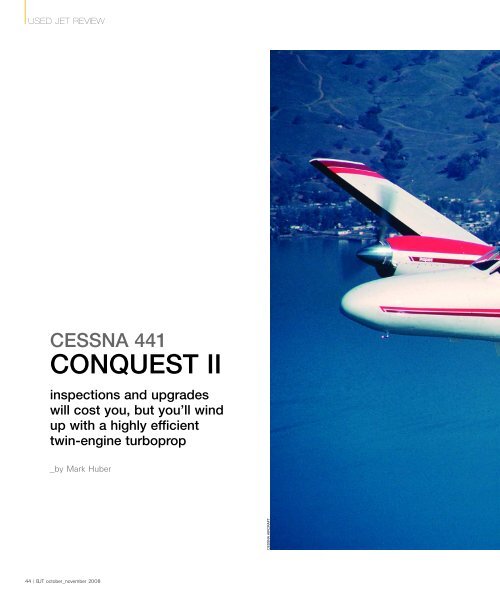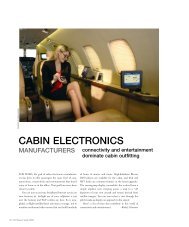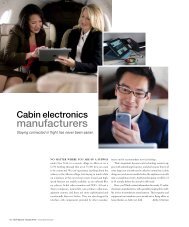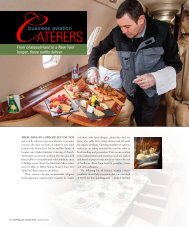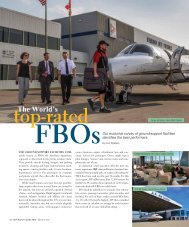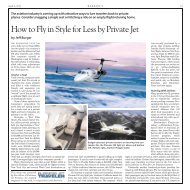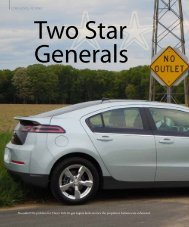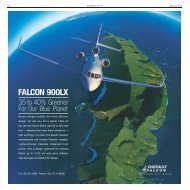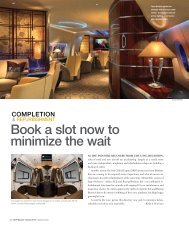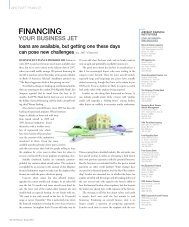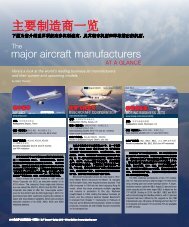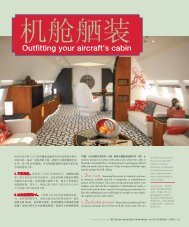CONQUEST II - Business Jet Traveler
CONQUEST II - Business Jet Traveler
CONQUEST II - Business Jet Traveler
Create successful ePaper yourself
Turn your PDF publications into a flip-book with our unique Google optimized e-Paper software.
USED JET REVIEW<br />
CESSNA 441<br />
<strong>CONQUEST</strong> <strong>II</strong><br />
inspections and upgrades<br />
will cost you, but you’ll wind<br />
up with a highly efficient<br />
twin-engine turboprop<br />
_by Mark Huber<br />
44 I BJT october_november 2008<br />
CESSNA AIRCRAFT
USED JET REVIEW<br />
$ (MILLIONS)<br />
THE CESSNA 441’S CABIN<br />
HAS EXECUTIVE SEATING FOR<br />
SEVEN, THOUGH YOU CAN<br />
CRAM IN 11 PASSENGERS.<br />
AIRPLANES COME APART IN MIDAIR for a variety of<br />
reasons. An errant pilot loses control or flies a model<br />
past its design limit, or unrepaired cracks and corrosion<br />
cause structure to fail. Fortunately, rigorous pilot<br />
training and aircraft maintenance standards make<br />
such events few and far between. Even rarer is the<br />
case when a design flaw brings down a relatively new<br />
airplane. Cessna, however, was facing that nightmare<br />
scenario in 1977 with its Model 441 Conquest <strong>II</strong>.<br />
During the 1960s, the company had developed its<br />
400 series of large-cabin piston twins; then, in 1972, it<br />
introduced the first Citation fanjet. But the 1973 Arab<br />
oil embargo and the continuing popularity of competing<br />
turboprops, such as the Beechcraft King Air, convinced<br />
Cessna to morph two of its piston twins–the<br />
2.0<br />
1.5<br />
1.0<br />
0.5<br />
0.0<br />
2003<br />
FAIR MARKET VALUE<br />
comparison of competitive aircraft<br />
Cessna Conquest <strong>II</strong><br />
Beechcraft King Air F90-1<br />
Piper Cheyenne <strong>II</strong>XL<br />
Mitsubishi MU-2 Marquise<br />
Twin Commander 690B<br />
2004<br />
2005<br />
BJT/Illustrator/802e_usedjetpreview_FMV_AugSept08.eps<br />
46 I BJT october_november 2008<br />
2006<br />
Source: Vref Aircraft Value Reference (www.vrefpub.com)<br />
2007<br />
2008<br />
404 and the 421–into turboprops. The 441 is the larger<br />
of the two; the other is the Model 425 Conquest I.<br />
The 441 has executive seating for seven, although you<br />
can cram in nine passengers; it also has a top speed<br />
of 295 knots–higher with a popular engine modification–and<br />
a range of 1,200 to 2,200 nautical miles,<br />
depending on altitude and power setting.<br />
Customer deliveries of the $895,000 Model 441<br />
began in September 1977. Just two months later, the<br />
sixth airplane off the production line came apart over<br />
Greensboro, Ala., killing all seven aboard. The engines<br />
were working fine and weather wasn’t a factor. That<br />
crash triggered the FAA’s grounding of the entire 441<br />
fleet–twice–between 1977 and 1979. Cessna ended up<br />
redesigning key tail-section components, retrofitting<br />
the entire fleet and providing customers with loaner aircraft.<br />
The program affected nearly 100 airplanes and<br />
still stands as one of the largest and most expensive<br />
factory field modifications of a business aircraft ever.<br />
The 441 went out of production in 1986–the year of<br />
general aviation’s modern nadir–after 362 were built.<br />
By then, the price of a new one had risen to $1.795 million.<br />
Of the approximately 320 still flying, the average<br />
accumulated flight time is 8,000 hours. The average<br />
operator flies about 294 hours a year.<br />
Used 441s hold their value well. In good condition,<br />
they still command $1.2 million to $1.7 million and<br />
many operators lavish their 441s with all the latest<br />
bells and whistles, including new paint, interior, video<br />
monitors, soundproofing and glass-panel avionics.<br />
Those upgrades can easily boost the investment past<br />
$3 million–about the price of a new (but smaller)<br />
Cessna Citation Mustang entry-level twinjet.<br />
“The airplane is in tight supply,” said Jerry Griffith, a<br />
WEST STAR AVIATION<br />
economics<br />
HOURLY DIRECT OPERATING COSTS<br />
– Fuel ($5.92 per gal): $526.88<br />
– Maintenance labor (at $81 per hour): $192.88<br />
– Parts, airframe, engine, avionics: $146.52<br />
– Inspections, component overhauls,<br />
engine restoration: $138.44<br />
– Misc. expenses<br />
Landing and parking fees: $8.13<br />
Crew expenses: $30<br />
Supplies & catering: $24<br />
TOTAL VARIABLE FLIGHT COSTS PER HOUR: $1,111.31<br />
Average speed: 270 knots<br />
– Cost per nautical mile: $4.12<br />
ANNUAL FIXED OPERATING COSTS<br />
– Crew salaries (estimates)<br />
Captain: $79,300<br />
Copilot: $41,200<br />
Benefits: $36,150<br />
– Hangar rental (typical): $20,900<br />
– Insurance (insured hull value = $1.735 million)<br />
Hull (1.02% of value): $17,697<br />
Admitted liability: $4,000<br />
Legal liability: $12,250<br />
– Recurrent crew training: $12,600<br />
– Aircraft modernization (avg per year): $45,000<br />
– Navigational chart service: $1,961<br />
– Refurbishing: $9,720<br />
– Computer maintenance program: $2,400<br />
– Aviation weather service (typical): $700<br />
TOTAL FIXED COST PER YEAR: $283,878<br />
ANNUAL BUDGET–BASED ON 115,000 NM<br />
(Utilization: 426 hours)<br />
– Variable cost: $473,418<br />
– Fixed cost: $283,878<br />
TOTAL COST (WITHOUT DEPRECIATION): $757,296<br />
– Per hour: $1,778<br />
– Per nautical mile: $6.59<br />
– Per seat nautical mile: $1.10<br />
Total cost (without depreciation): $757,296<br />
– Book depreciation (10% per year): $173,500<br />
TOTAL COST (WITH BOOK DEPRECIATION): $930,796<br />
– Per hour: $2,185<br />
– Per nautical mile: $8.09<br />
– Per seat nautical mile: $1.35<br />
Total cost (without depreciation): $757,296<br />
– Market depreciation: $69,400<br />
TOTAL COST (WITH MARKET DEPRECIATION): $826,696<br />
– Per hour: $1,941<br />
– Per nautical mile: $7.19<br />
– Per nautical seat mile: $1.20<br />
Source: Conklin & de Decker, Orleans, Mass.
USED JET REVIEW<br />
Model<br />
Tulsa, Okla. broker who specializes in the 441. Griffith<br />
cited its speed, range, fuel economy and comparably low<br />
engine maintenance costs as the chief reasons for its<br />
enduring popularity. “When you look at the amount of<br />
the investment, operating costs and capability, nothing<br />
else will do what this airplane does,” Griffith added. A<br />
441 with upgraded Honeywell TPE331-10 engines can<br />
take six passengers and their gear 1,200 nautical miles<br />
at speeds up to 311 knots at 35,000 feet–with an hourly<br />
fuel burn of 75 gallons. Down at 24,000 feet, it’s even<br />
faster. Lighten the load and pull back the power and you<br />
can stretch a tank of gas out to 2,200 nautical miles,<br />
making 253 knots. The engines have a recommended<br />
time-between-overhaul (TBO) of 5,000 hours and cost<br />
about $175,000 each to overhaul. Those are much better<br />
numbers than the ones for the Pratts that power King<br />
Airs and Cheyennes. The Pratts on a King Air B200 have<br />
a TBO of 3,600 hours, drink 25 gallons an hour more and<br />
cruise 20 knots slower. The Honeywell Dash 10s also give<br />
good short runway performance and get to altitude fast,<br />
powering the climb at a rate of 2,435 feet per minute.<br />
Cessna made many product improvements and retrofit<br />
kits available for the 441 during its nine-year production<br />
run–and the aftermarket added others. Chief among<br />
these was the Dash 10 engine conversion pioneered by<br />
West Star Aviation in Grand Junction, Colo. Most of the<br />
fleet has been converted to Dash 10 power, and because<br />
of the superior performance and maintenance intervals,<br />
you simply do not want a 441 without it. The conversion<br />
typically is done when the original Garrett TPE331<br />
engines are timed out or need a mid-life inspection; the<br />
cost is north of $500,000 for two engines.<br />
Stainless exhausts are another popular option and<br />
cost around $5,000 per side. The original fiberglass<br />
exhaust area is prone to cracking.<br />
Next come the propellers. If your 441 hasn’t been<br />
converted to four-blade Hartzell propellers already, con-<br />
48 I BJT october_november 2008<br />
CESSNA 441 <strong>CONQUEST</strong> <strong>II</strong> COMPARED<br />
First<br />
Year<br />
Built<br />
Variable<br />
cost/hour<br />
Seats<br />
exec/max Range<br />
(nm)<br />
Max<br />
cruise (kt)<br />
Max<br />
takeoff<br />
weight (lb)<br />
BEECHCRAFT KING AIR F90-1 1979 $1,370 6/8 1,040 265 10,950<br />
CESSNA 441 <strong>CONQUEST</strong> <strong>II</strong>-10 1978 $1,111 7/9 1,494 314 9,850<br />
MITSUBISHI MU-2 1979 $1,089 6/9 1,012 300 11,575<br />
PIPER CHEYENNE <strong>II</strong>IA 1984 $1,493 6/9 1,240 305 11,200<br />
ROCKWELL TWIN COMMANDER 690B 1977 $1,279 6/7 942 285 10,325<br />
Assumptions: All aircraft are 1984 models except the Commander, which is from 1979 (last year produced). <strong>Jet</strong> fuel $5.92/gal;<br />
variable cost: fuel plus maintenance reserves and misc. expenses; four passengers; NBAA IFR reserve fuel; passenger<br />
weight 200 lb includes baggage; two pilots.<br />
Cost source: Conklin & de Decker Life Cycle Cost<br />
Performance source: Conklin & de Decker Aircraft Performance Comparator, Orleans, Mass.<br />
sider it. The four blades yield 2.5 inches more ground<br />
clearance, reduce cabin noise, improve the climb rate by<br />
200 feet per minute and add four to five knots of airspeed,<br />
according to Greg Thibodeau, airframe maintenance<br />
director at National Flight Services in Toledo,<br />
Ohio. Two new props, installed, run about $65,000.<br />
National also offers winglets for the 441. Installation<br />
requires eight to 10 days of downtime and painting<br />
costs $14,000. Thibodeau said pilots report speed<br />
gains of three to five knots and that the winglets make<br />
the airplane “more stable about the roll axis.”<br />
Next come avionics. The factory-installed Cessna<br />
autopilots on this airplane are, to be blunt, junk–and<br />
about 70 percent of the 441s still flying have them. They<br />
are unreliable analog dinosaurs prone to failure, and<br />
parts are hard to get. Most 441s are flown single-pilot<br />
and you need a good autopilot to reduce pilot workload.<br />
Cessna figured this out eventually, installing Sperry<br />
SPZ500s on the last 20 airplanes out the door. Retrofits<br />
are primarily the Rockwell Collins APS-65 or the S-Tec<br />
2100. Some operators already made the switch when<br />
they installed RVSM altimeters, which are now required<br />
to fly above 28,000 feet. A complete avionics upgrade<br />
of a 441 with an ancient panel will run about $400,000<br />
and that gives you everything–good autopilot, XM satel-<br />
WEST STAR AVIATION<br />
specifications<br />
CABIN DIMENSIONS<br />
– Height: 4.3 ft<br />
– Width: 4.6 ft<br />
– Length: 14.35 ft<br />
– Volume: 235 cu ft<br />
– Door height: 4.25 ft<br />
– Door width: 2.08 ft<br />
BAGGAGE: 51 cu ft (internal)<br />
26 cu ft (external)<br />
TYPICAL SEATS:<br />
CREW/PASSENGERS (EXECUTIVE): 2/6<br />
MAXIMUM WEIGHTS<br />
– Takeoff: 9,850 lb<br />
– Landing: 9,360 lb<br />
– Basic operating: 6,200 lb<br />
– Usable fuel: 3,183 lb<br />
– Maximum payload: 2,300 lb<br />
– Payload with full fuel: 542 lb<br />
performance<br />
RANGE (IFR NBAA 200 nm reserve)<br />
– Seats full: 1,200 nm<br />
– Ferry range: 1,720 nm<br />
RATE OF CLIMB<br />
– 2,435 fpm<br />
CRUISE SPEED<br />
– Max: 311 ktas<br />
– Long range: 253 ktas<br />
SERVICE CEILING<br />
– 35,000 ft<br />
Source: Conklin & de Decker, Orleans, Mass.<br />
THE FACTORY-INSTALLED AUTOPILOTS ON<br />
THE CESSNA 441 ARE UNRELIABLE AND<br />
PARTS ARE HARD TO GET, BUT AVIONICS<br />
UPGRADE, SUCH AS THE AVIDYNE ALLIANT<br />
INTERGRATED GLASS PANEL SYSTEM (LEFT),<br />
ARE AVAILABLE FOR RETROFIT.
USED JET REVIEW<br />
lite weather, RVSM, GPS/comms and traffic and terrain<br />
avoidance. The Avidyne Alliant integrated glass-panel<br />
system is also available.<br />
Making a big investment in a 30-year-old airplane<br />
is not without risk, and operators must adhere to a rigorous,<br />
recently mandated inspection program for all<br />
441s. The initial inspection under this program is<br />
pricey, anywhere from $120,000 to $180,000 or more,<br />
depending upon what is uncovered. The engines, propellers,<br />
de-icing boots, tail and landing gear must all<br />
be removed. Once the boots come off, you cannot put<br />
them back on–you have to buy new ones. Ka-ching.<br />
The interior also comes out of the airplane as part<br />
of this initial inspection. This is a good time to refurbish.<br />
Turboprop cabins are generally noisy places and<br />
the 441’s is no exception. However, a 50-pound Flight<br />
Environments sound-dampening package can cut<br />
noise by up to nine decibels. In conjunction with an<br />
inspection, it takes a week to install and costs about<br />
$25,000. New paint and interior averages $75,000,<br />
unless you go crazy with cabin electronics.<br />
The initial inspection takes four to eight weeks.<br />
Less intensive recurring inspections are required over<br />
the aircraft’s life and will add $50 an hour to direct<br />
operating costs. Cessna is also limiting the life of a<br />
441’s airframe to 22,500 hours (about 77 years of<br />
average use), but that limit applies only to aircraft<br />
flown commercially—although some insurers will also<br />
apply that standard to private-use aircraft.<br />
Cessna claims the new inspection and life-limit<br />
rules are necessary. “Our main concern is corrosion<br />
related to the age of these airplanes,” said Steve<br />
Howard, Cessna’s manager of field service for propeller<br />
aircraft. However, a few cynical 441 owners told<br />
me they think the new rules are really designed to<br />
stave off crash-related lawsuits. In 1994, Congress<br />
eliminated aircraft manufacturers’ product liability for<br />
aircraft that are more than 18 years old unless those<br />
aircraft are used for a variety of commercial purposes.<br />
Model<br />
The rules also don’t cover lawsuits filed outside the<br />
U.S., where about one third of the 441 fleet resides.<br />
But most 441 owners have taken the new inspections<br />
rules in stride and are using them as an opportunity to<br />
refurbish and add equipment, according to West Star’s<br />
vice president of business development, Russ Williams.<br />
“They’re not asking, ‘How much?’” Williams commented.<br />
“They are asking, ‘When can I get my airplane back?’”<br />
Williams said there is a compelling reason for this.<br />
“No twin-engine turboprop that I know of is more efficient<br />
in terms of cost per seat mile and cost per hour,”<br />
he explained. Not bad for a design that first took to the<br />
drawing board in 1974. ■<br />
Mark Huber welcomes comments and suggestions at:<br />
mhuber@bjtonline.com.<br />
SUPPORT & SERVICE | CESSNA <strong>CONQUEST</strong> & COMPETITORS<br />
Overall<br />
Average<br />
2008<br />
Overall<br />
Average<br />
2007<br />
Authorized<br />
Service<br />
Centers<br />
Factory<br />
Service<br />
Centers<br />
Parts<br />
Availability<br />
Cost<br />
of Parts<br />
Aircraft on<br />
the Ground<br />
Response<br />
CESSNA IS LIMITING THE LIFE OF A<br />
441’S AIRFRAME TO 22,500 HOURS–<br />
ABOUT 77 YEARS OF AVERAGE USE.<br />
Warranty<br />
Fulfillment<br />
Technical<br />
Manuals<br />
MITSUBISHI (MU-2, SOLITAIRE, MARQUISE) 9.17 N/A 9.27 9.49 9.25 8.12 9.38 9.09 8.94 9.32 9.64<br />
HAWKER BEECHCRAFT (KING AIR) 7.14 7.07 7.26 6.75 7.21 5.67 7.22 7.01 7.46 7.42 8.11<br />
CESSNA (<strong>CONQUEST</strong>) 6.61 5.88 7.38 6.54 6.29 6.00 6.09 5.22 6.92 6.27 8.07<br />
PIPER (CHEYENNE) 5.96 5.97 6.88 4.00 5.82 5.41 6.05 4.50 5.75 6.06 7.82<br />
Rating scale–1 to 10: 1-inadequate; 3-poor; 5.5-average; 8-good; 10-excellent. Ratings are for turboprops that are more than 10 years old.<br />
Source: Aviation International News, 2008 Product Support Survey<br />
50 I BJT october_november 2008<br />
Model<br />
CESSNA 441 <strong>CONQUEST</strong> <strong>II</strong> SAFETY RECORD COMPARED<br />
(accident rates per 100,000 flight hours)<br />
PIPER CHEYENNE 1.81 0.79 0.97 0.49<br />
CESSNA 441 <strong>CONQUEST</strong> <strong>II</strong> 1.89 0.95 1.19 0.59<br />
BEECHCRAFT KING AIR 90 1.97 0.61 1.24 0.41<br />
ROCKWELL COMMANDER 690 3.46 1.3 1.69 0.85<br />
MITSUBISHI MU-2 3.89 1.69 1.39 0.88<br />
Source: Robert E. Breiling & Associates<br />
All years (through 2007) Last five years (2003-2007)<br />
All Accidents Fatal Accidents All Accidents Fatal Accidents<br />
Technical<br />
Reps<br />
Aircraft<br />
Reliability<br />
WEST STAR AVIATION


